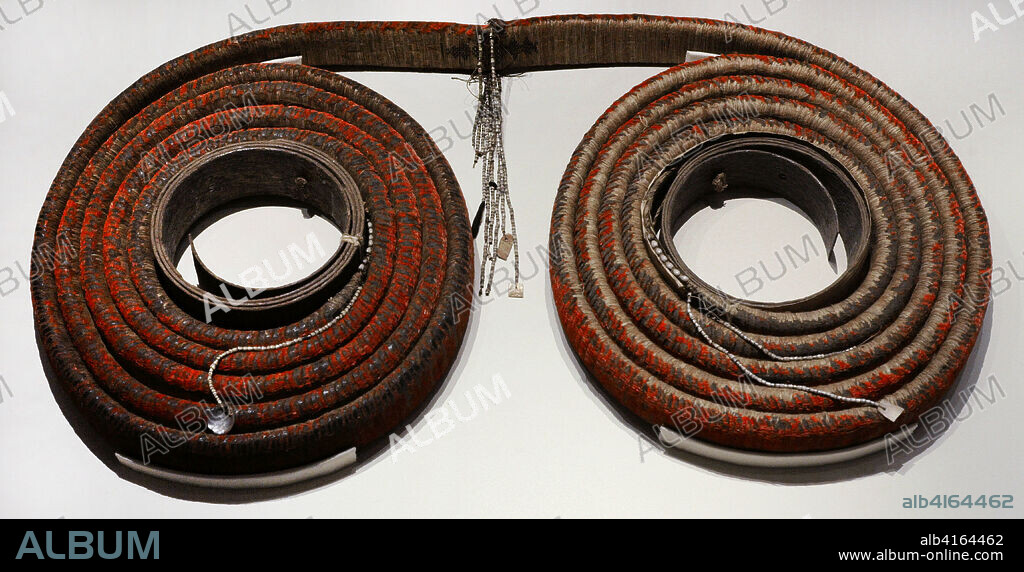alb4164462
Tevau, also called "feather money". It consisted of a strip of plant fiber about 7 cm. wide and 10 m. long, wheel-shaped threaded on two rings of tree bark, being woven on one side with rows of tiny red feathers superimposed, of a honey-eating bird called Cardinal Myzomela. Its manufacture was very complex and was passed down from father to son, since its magical components were not within the reach of everyone. These feather rolls were used as money for ritual payments, such as the marriage ceremony, and to acquire high-value goods. They were carefully stored in dry and warm places to preserve their flexibility and color. Despite the massive influx of Australian coins and banknotes since World War II, this form of money continued to be used for traditional payments until at least the 1950s. In 1975, the existing tevau were declared cultural heritage, prohibiting the government from exporting them outside the islands. 19th-20th century. Santa Cruz Islands (Solomon Islands, Oceania). National Archaeological Museum. Madrid. Spain.

|
Add to another lightbox |
|
Add to another lightbox |



Caption:
Tevau, also called "feather money". It consisted of a strip of plant fiber about 7 cm. wide and 10 m. long, wheel-shaped threaded on two rings of tree bark, being woven on one side with rows of tiny red feathers superimposed, of a honey-eating bird called Cardinal Myzomela. Its manufacture was very complex and was passed down from father to son, since its magical components were not within the reach of everyone. These feather rolls were used as money for ritual payments, such as the marriage ceremony, and to acquire high-value goods. They were carefully stored in dry and warm places to preserve their flexibility and color. Despite the massive influx of Australian coins and banknotes since World War II, this form of money continued to be used for traditional payments until at least the 1950s. In 1975, the existing tevau were declared cultural heritage, prohibiting the government from exporting them outside the islands. 19th-20th century. Santa Cruz Islands (Solomon Islands, Oceania). National Archaeological Museum. Madrid. Spain.
Location:
National Archaeological Museum. Madrid. Spain.
Credit:
Album / Prisma
Releases:
Model: No - Property: No
Rights questions?
Rights questions?
Image size:
4606 x 2334 px | 30.8 MB
Print size:
39.0 x 19.8 cm | 15.4 x 7.8 in (300 dpi)
Keywords:
19TH CENTURY • 19TH • 20 CENTURY • 20 XX TWENTIETH CENTURY • 20TH CENTURY • 20TH • ARTISAN (FEMALE) = CRAFTSWOMAN • ARTISAN (FEMALE) • ARTISAN • BIRD • BIRDS • BUY • COIL • COILED • COILS • COIN • COINS • COMPLEX • COMPLEXITY • CONSTRUCTION_AND_PROPERTY • COURAGE • CRAFTS • CRAFTSMAN • CRAFTSMANSHIP • CRAFTSWOMAN • CURRENCY • DEVELOPMENT • DIFFICULT • DIFFICULTY • DINERO • ECONOMY • ÉLABORATION • FABRICATION • FEATHER MONEY • FEATHER ROLLS • FEATHER • FEATHERS • FIBER • GOODS • HANDICRAFT • HIGH VALUE • HISTORIA UNIVERSAL • HISTORIA • HISTORY • MANUFACTURE • MANUFACTURING • MONEY COIL • MONEY • MUNGAU • MYZOMELA CARDINALIS • NATIONAL ARCHAEOLOGICAL MUSEUM. MADRID. SPAIN. • OCEANIA • OVERLAPPING FEATHERS • PACIFIC CULTURE • PACIFIC CULTURES • PAY • PAYMENT (DEPOSIT) • PAYMENT • PAYMENTS • PLANT FIBER • PLANT FIBRE • POSSESSION • PRODUCING • PRODUCTION • PRODUCTIONS • PROPERTY • RITUAL PAYMENT • RITUAL PAYMENTS • ROLL OF FEATHERS • ROLL • ROLLED UP • ROLLS • SANTA CRUZ ISLANDS • SCARLET HONEYEATER • SCREW IN • SCREW • SHOP • SOLOMON ISLANDS • SPIRAL (SHAPE) • SPIRAL • SPIRALS • STRIP • STRIPS • SYSTEM • TEMOTU • TEVAU • TIRRAU • TRADITION • TRADITIONAL • TRADITIONS • TWENTIETH CENTURY • VALOUR • VALUE • VEGETABLE FIBER • XIX CENTURY • XIX • XX
 Pinterest
Pinterest Twitter
Twitter Facebook
Facebook Copy link
Copy link Email
Email

